GMC SONOMA 2001 Repair Manual
Manufacturer: GMC, Model Year: 2001, Model line: SONOMA, Model: GMC SONOMA 2001Pages: 407, PDF Size: 2.77 MB
Page 61 of 407
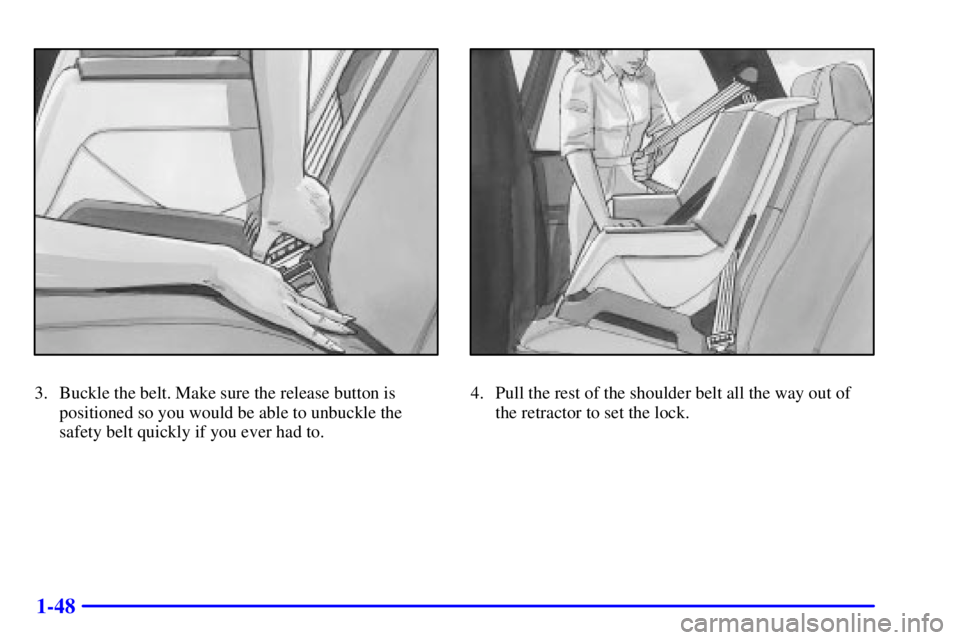
1-48
3. Buckle the belt. Make sure the release button is
positioned so you would be able to unbuckle the
safety belt quickly if you ever had to.4. Pull the rest of the shoulder belt all the way out of
the retractor to set the lock.
Page 62 of 407
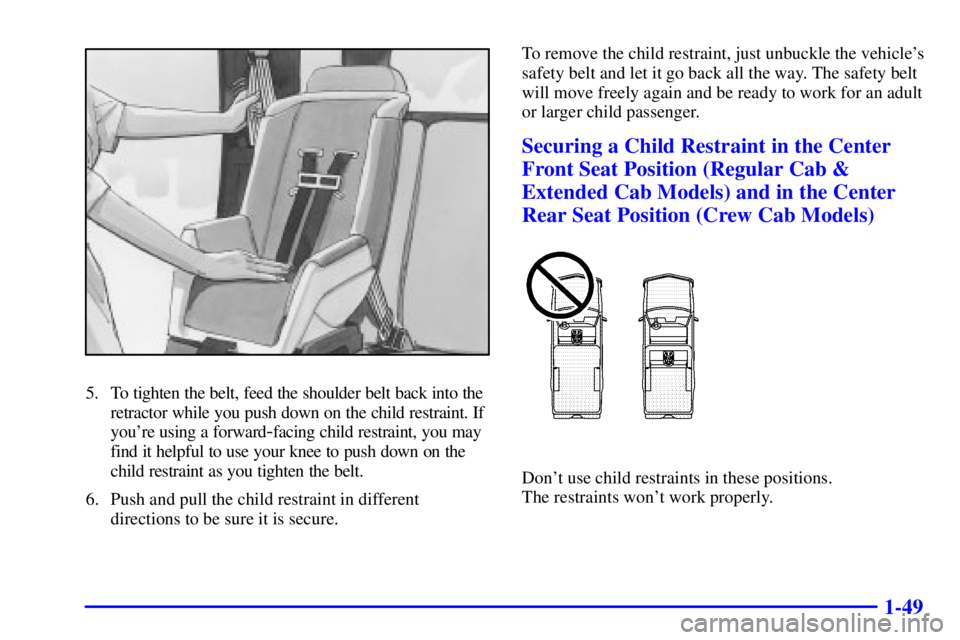
1-49
5. To tighten the belt, feed the shoulder belt back into the
retractor while you push down on the child restraint. If
you're using a forward
-facing child restraint, you may
find it helpful to use your knee to push down on the
child restraint as you tighten the belt.
6. Push and pull the child restraint in different
directions to be sure it is secure.To remove the child restraint, just unbuckle the vehicle's
safety belt and let it go back all the way. The safety belt
will move freely again and be ready to work for an adult
or larger child passenger.
Securing a Child Restraint in the Center
Front Seat Position (Regular Cab &
Extended Cab Models) and in the Center
Rear Seat Position (Crew Cab Models)
Don't use child restraints in these positions.
The restraints won't work properly.
Page 63 of 407
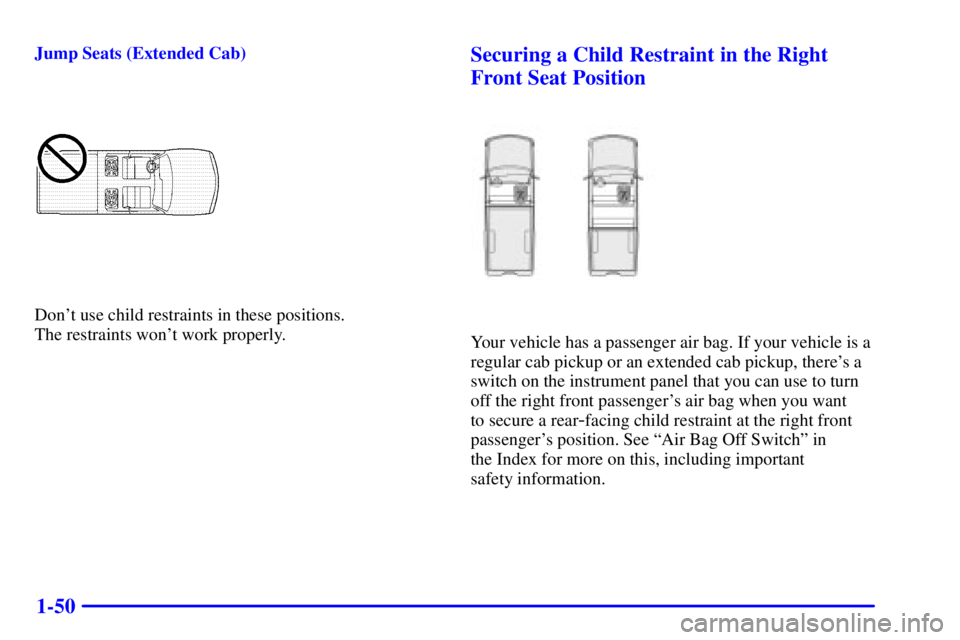
1-50
Jump Seats (Extended Cab)
Don't use child restraints in these positions.
The restraints won't work properly.
Securing a Child Restraint in the Right
Front Seat Position
Your vehicle has a passenger air bag. If your vehicle is a
regular cab pickup or an extended cab pickup, there's a
switch on the instrument panel that you can use to turn
off the right front passenger's air bag when you want
to secure a rear
-facing child restraint at the right front
passenger's position. See ªAir Bag Off Switchº in
the Index for more on this, including important
safety information.
Page 64 of 407
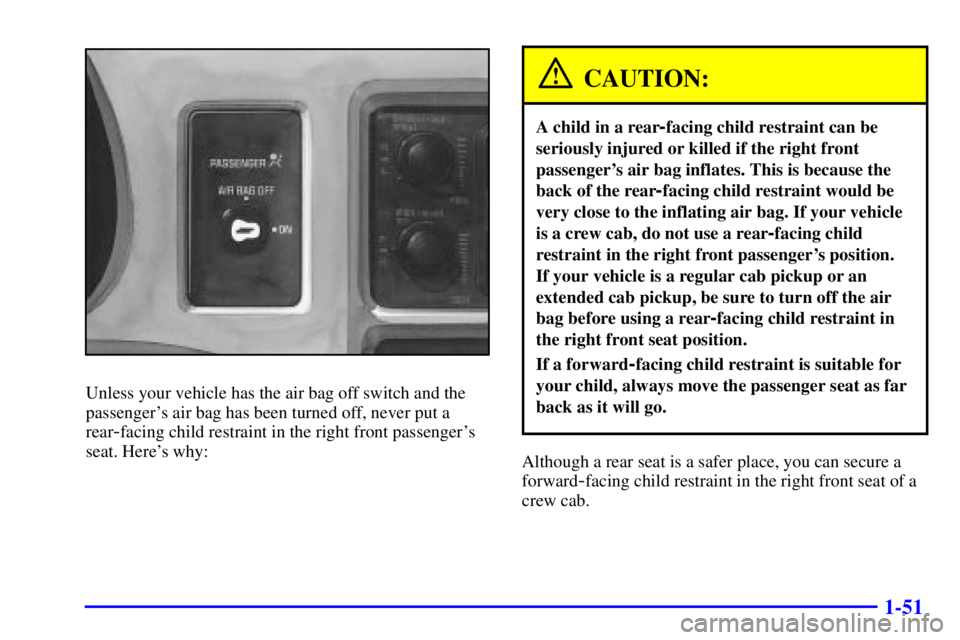
1-51
Unless your vehicle has the air bag off switch and the
passenger's air bag has been turned off, never put a
rear
-facing child restraint in the right front passenger's
seat. Here's why:
CAUTION:
A child in a rear-facing child restraint can be
seriously injured or killed if the right front
passenger's air bag inflates. This is because the
back of the rear
-facing child restraint would be
very close to the inflating air bag. If your vehicle
is a crew cab, do not use a rear
-facing child
restraint in the right front passenger's position.
If your vehicle is a regular cab pickup or an
extended cab pickup, be sure to turn off the air
bag before using a rear
-facing child restraint in
the right front seat position.
If a forward-facing child restraint is suitable for
your child, always move the passenger seat as far
back as it will go.
Although a rear seat is a safer place, you can secure a
forward
-facing child restraint in the right front seat of a
crew cab.
Page 65 of 407
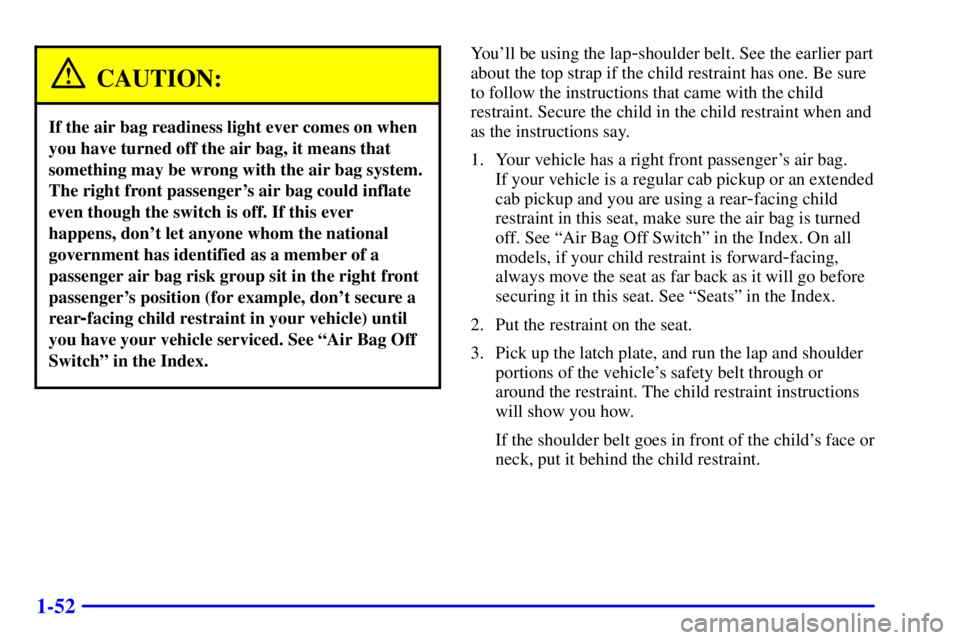
1-52
CAUTION:
If the air bag readiness light ever comes on when
you have turned off the air bag, it means that
something may be wrong with the air bag system.
The right front passenger's air bag could inflate
even though the switch is off. If this ever
happens, don't let anyone whom the national
government has identified as a member of a
passenger air bag risk group sit in the right front
passenger's position (for example, don't secure a
rear
-facing child restraint in your vehicle) until
you have your vehicle serviced. See ªAir Bag Off
Switchº in the Index.
You'll be using the lap-shoulder belt. See the earlier part
about the top strap if the child restraint has one. Be sure
to follow the instructions that came with the child
restraint. Secure the child in the child restraint when and
as the instructions say.
1. Your vehicle has a right front passenger's air bag.
If your vehicle is a regular cab pickup or an extended
cab pickup and you are using a rear
-facing child
restraint in this seat, make sure the air bag is turned
off. See ªAir Bag Off Switchº in the Index. On all
models, if your child restraint is forward
-facing,
always move the seat as far back as it will go before
securing it in this seat. See ªSeatsº in the Index.
2. Put the restraint on the seat.
3. Pick up the latch plate, and run the lap and shoulder
portions of the vehicle's safety belt through or
around the restraint. The child restraint instructions
will show you how.
If the shoulder belt goes in front of the child's face or
neck, put it behind the child restraint.
Page 66 of 407
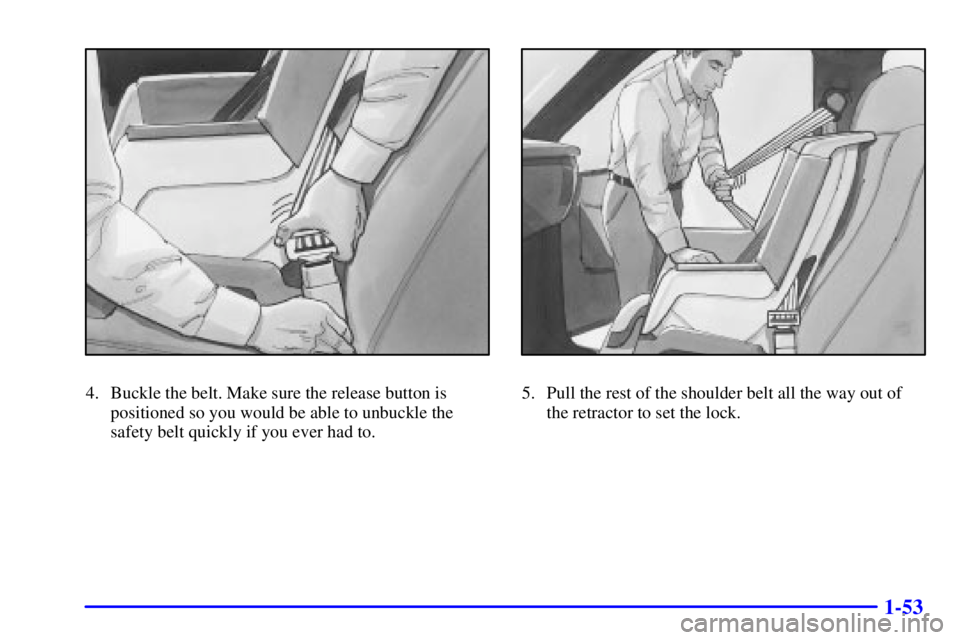
1-53
4. Buckle the belt. Make sure the release button is
positioned so you would be able to unbuckle the
safety belt quickly if you ever had to.5. Pull the rest of the shoulder belt all the way out of
the retractor to set the lock.
Page 67 of 407
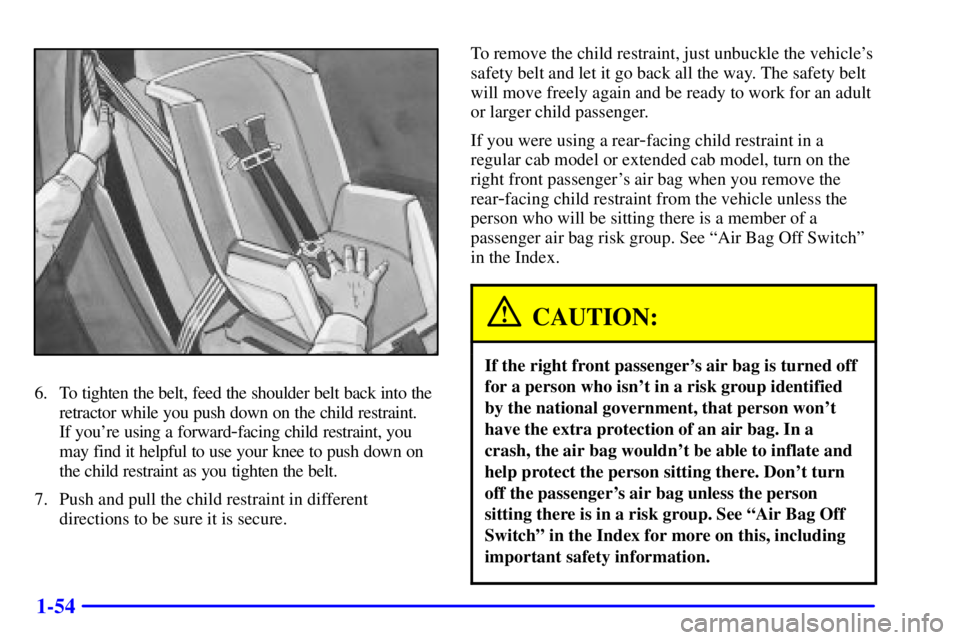
1-54
6. To tighten the belt, feed the shoulder belt back into the
retractor while you push down on the child restraint.
If you're using a forward
-facing child restraint, you
may find it helpful to use your knee to push down on
the child restraint as you tighten the belt.
7. Push and pull the child restraint in different
directions to be sure it is secure.To remove the child restraint, just unbuckle the vehicle's
safety belt and let it go back all the way. The safety belt
will move freely again and be ready to work for an adult
or larger child passenger.
If you were using a rear
-facing child restraint in a
regular cab model or extended cab model, turn on the
right front passenger's air bag when you remove the
rear
-facing child restraint from the vehicle unless the
person who will be sitting there is a member of a
passenger air bag risk group. See ªAir Bag Off Switchº
in the Index.
CAUTION:
If the right front passenger's air bag is turned off
for a person who isn't in a risk group identified
by the national government, that person won't
have the extra protection of an air bag. In a
crash, the air bag wouldn't be able to inflate and
help protect the person sitting there. Don't turn
off the passenger's air bag unless the person
sitting there is in a risk group. See ªAir Bag Off
Switchº in the Index for more on this, including
important safety information.
Page 68 of 407
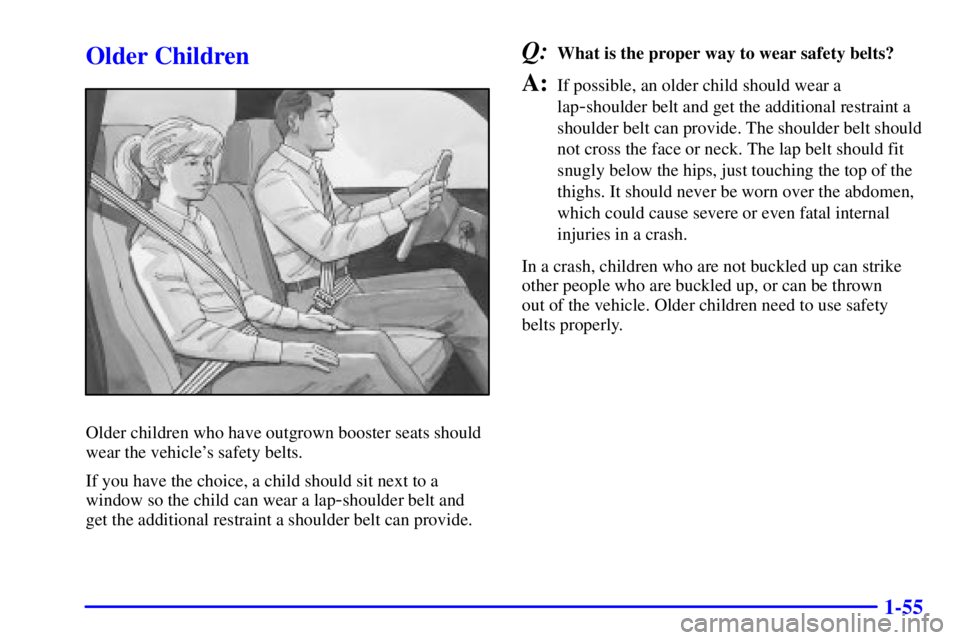
1-55
Older Children
Older children who have outgrown booster seats should
wear the vehicle's safety belts.
If you have the choice, a child should sit next to a
window so the child can wear a lap
-shoulder belt and
get the additional restraint a shoulder belt can provide.
Q:What is the proper way to wear safety belts?
A:If possible, an older child should wear a
lap
-shoulder belt and get the additional restraint a
shoulder belt can provide. The shoulder belt should
not cross the face or neck. The lap belt should fit
snugly below the hips, just touching the top of the
thighs. It should never be worn over the abdomen,
which could cause severe or even fatal internal
injuries in a crash.
In a crash, children who are not buckled up can strike
other people who are buckled up, or can be thrown
out of the vehicle. Older children need to use safety
belts properly.
Page 69 of 407
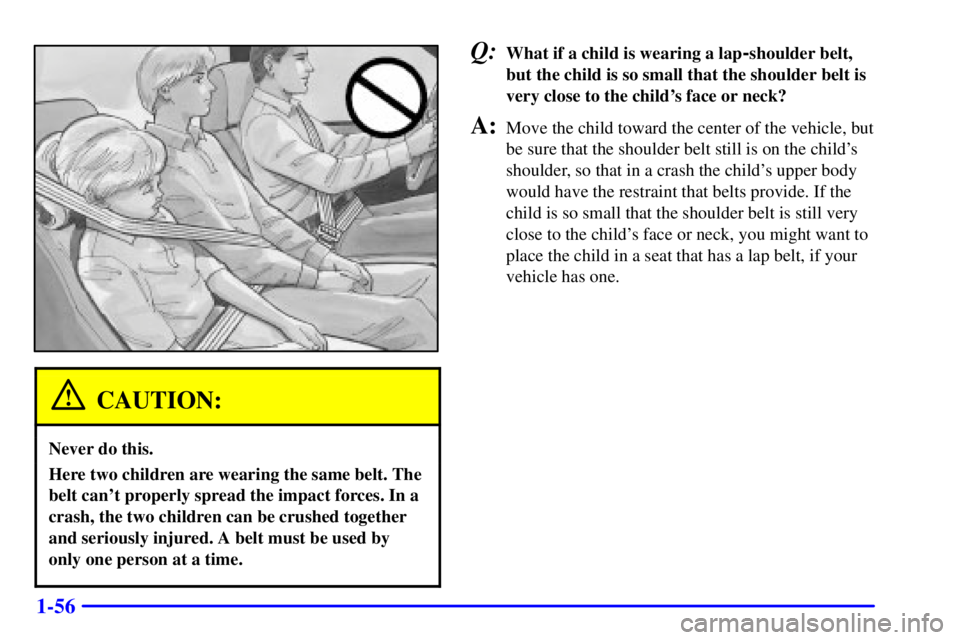
1-56
CAUTION:
Never do this.
Here two children are wearing the same belt. The
belt can't properly spread the impact forces. In a
crash, the two children can be crushed together
and seriously injured. A belt must be used by
only one person at a time.
Q:What if a child is wearing a lap-shoulder belt,
but the child is so small that the shoulder belt is
very close to the child's face or neck?
A:Move the child toward the center of the vehicle, but
be sure that the shoulder belt still is on the child's
shoulder, so that in a crash the child's upper body
would have the restraint that belts provide. If the
child is so small that the shoulder belt is still very
close to the child's face or neck, you might want to
place the child in a seat that has a lap belt, if your
vehicle has one.
Page 70 of 407
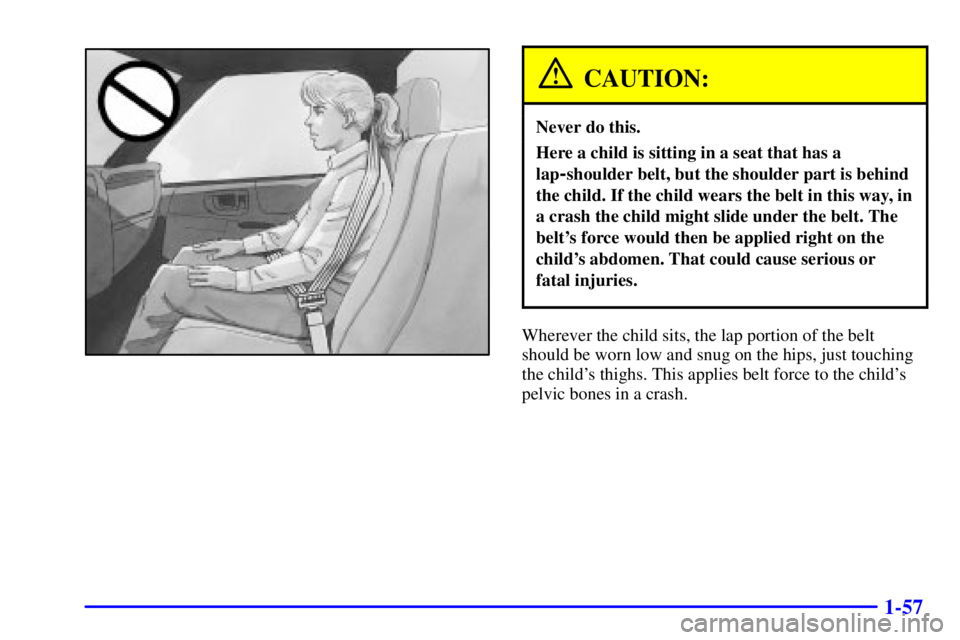
1-57
CAUTION:
Never do this.
Here a child is sitting in a seat that has a
lap
-shoulder belt, but the shoulder part is behind
the child. If the child wears the belt in this way, in
a crash the child might slide under the belt. The
belt's force would then be applied right on the
child's abdomen. That could cause serious or
fatal injuries.
Wherever the child sits, the lap portion of the belt
should be worn low and snug on the hips, just touching
the child's thighs. This applies belt force to the child's
pelvic bones in a crash.